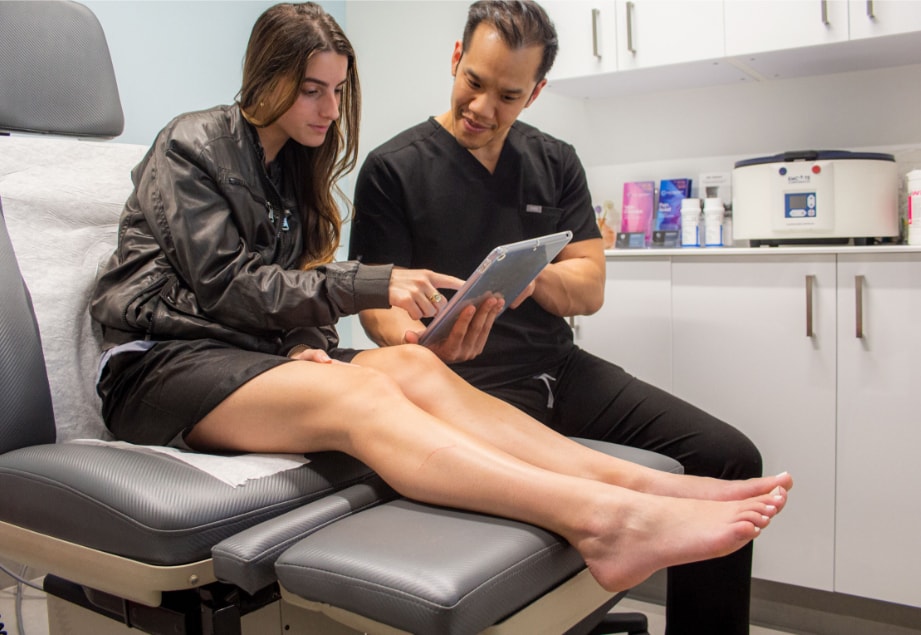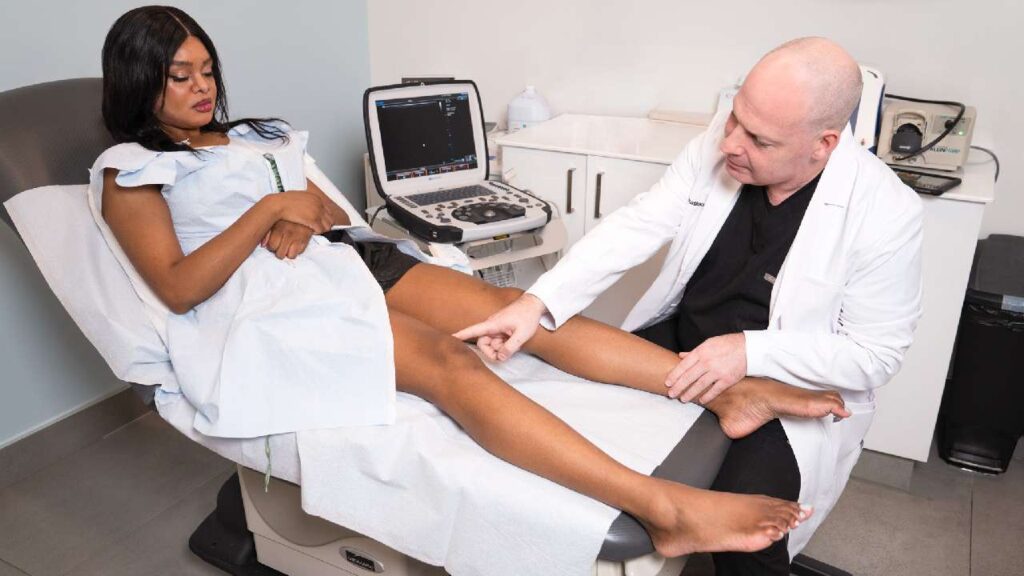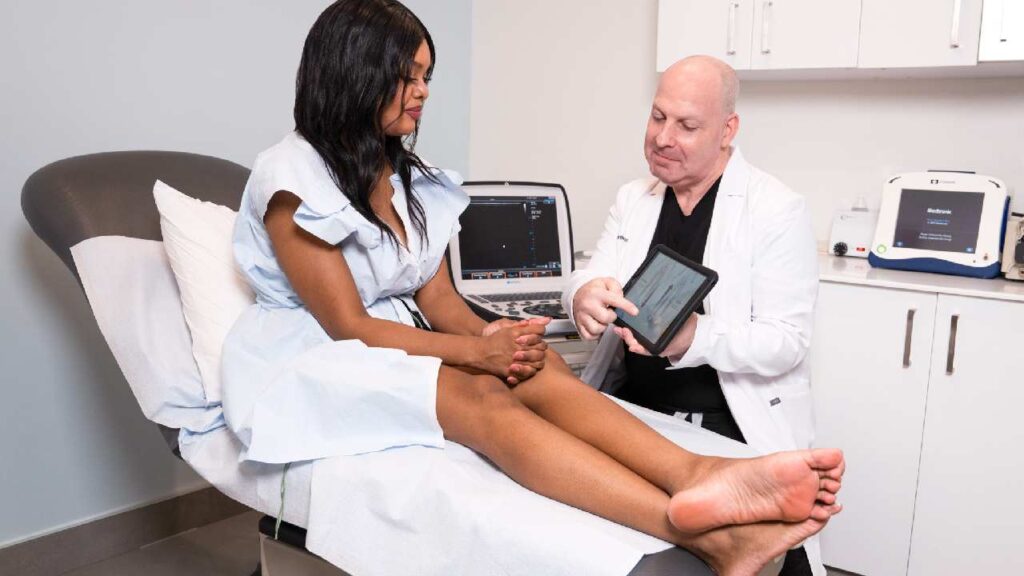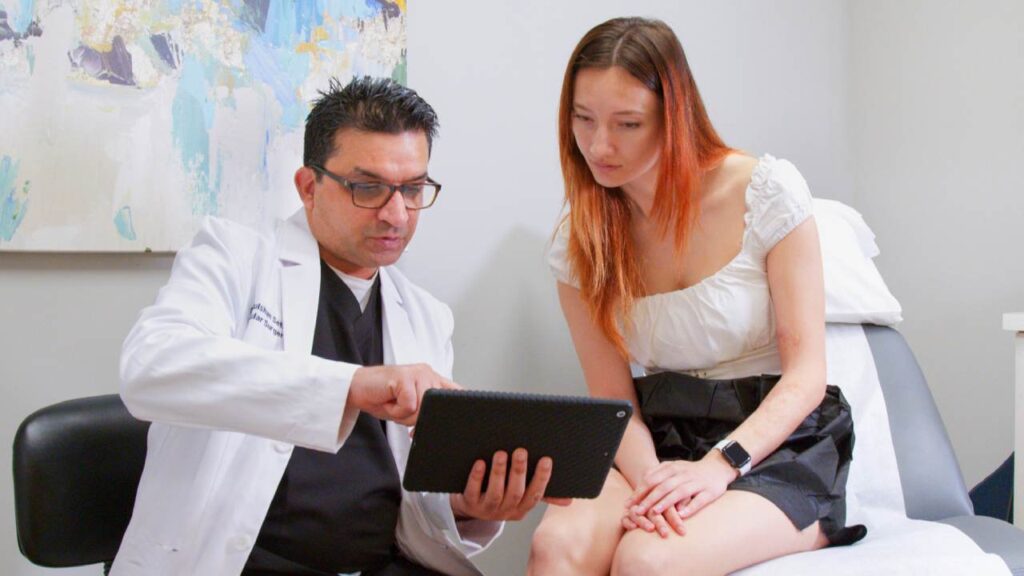What Are the Treatment Options for Leg Vein Removal Near Me?
Treatment for varicose veins has come a long way. There are now several ways to remove those bothersome veins, most of which are non-surgical. There is no singular solution that’s right for everyone. The best method is determined by your medical history, symptoms, and unique venous pathways. In case you’re wondering if there’s a DIY method, home remedies can help symptoms, but they can’t remove varicose veins.
Your vein doctor might suggest that you wear compression stockings or avoid sitting or standing for long periods. These are good tactics for managing pain, swelling, and inefficient circulation. But once you have a varicose vein, a treatment is the way to erase it. Book an appointment for quick resolution of varicose veins or spider veins. Here’s how to treat varicose veins, rather than manage them.
- Sclerotherapy
- Radiofrequency Ablation
- Vein Adhesives
- Mechanochemical Ablation
- Endovenous Laser Ablation
- Surface Laser Treatment
- Phlebectomy
- Ambulatory Phlebectomy

Why Does Some Vein Anatomy Require Vein Clinic Treatments?
A vein’s anatomy includes three layers. The innermost layer is lined with tiny valves that are meant to close once blood flows through. This ensures that blood returns to the heart, rather than pooling in the vein or traveling backward. If a valve fails to close tightly, blood pressure increases, causing veins to swell. This is called Chronic Venous Insufficiency. If you’ve noticed that varicose veins are swollen, twisted, and protrusive, this excess pressure is the reason.
Increased pressure in the veins can also generate tiny new blood vessels that branch out from the engorged vein. These are called spider veins. The reason some blood vessels require vein clinic treatment is that there are broken valves in the vein’s anatomy. If you don’t treat this, the vein damage won’t disappear, and more vein damage is likely to develop. Tactics like avoiding sitting or standing for a long period of time might help symptoms, but they can’t repair the anatomy of the vein.
If you’re considering how to treat varicose veins, it helps to understand what each vein treatment does. Come see our vein specialists to learn which techniques you’re eligible for. Our Harvard-trained doctors love explaining what they do and why they recommend certain procedures. Below, you’ll find a brief synopsis of how various treatments work.
What Are the RFA, EVLA, and Sclerotherapy Meanings?
- Sclerotherapy– (Common names: Varithena, Asclera)
Sclerotherapy is an injection of liquid or foam sclerosants. The most common agent is polidocanol. Sclerosants irritate the vein’s walls, creating intentional scar tissue that seals the vein shut. Blood stops flowing into the malfunctioning vein, and it disappears. No anesthesia is needed.
- Mechanochemical Ablation– (Common name: ClariVein)
Mechanochemical ablation combines sclerotherapy with mechanical disruption of veins. A catheter releases a sclerosant and also rotates to agitate the vein. This dual approach treats large or stubborn veins. No anesthesia is needed.
- Radiofrequency Ablation– (Common names: Closurefast, VNUS Closure)
Radiofrequency Ablation (RFA) uses a tiny catheter to deliver radiofrequency to the vein. This produces thermal energy which shrinks the collagen in the vein wall, collapsing the vein. Blood is rerouted into healthy veins, and the diseased vein is absorbed. Vein doctors inject tumescent anesthesia around the vein to protect surrounding tissue from heat. No spinal or general anesthesia is needed.
- Endovenous Laser Ablation– (Common names: VenaCure, ELVes, VeinSeal)
Endovenous Laser Ablation (EVLA) works like radiofrequency ablation, except vein doctors use lasers, rather than sound waves, to heat veins. Unlike surface laser treatments, endovenous lasers position the laser on the vein, rather than the skin. Doctors inject tumescent anesthesia around the vein, as with RFA. No other anesthetics are needed.
- Vein Adhesives– (Common name: VenaSeal)
Vein adhesive treatments inject cyanoacrylate glue into the vein to seal it. This glue has been widely used in cardiac and surgical procedures. Now, it’s formulated to close varicose veins and spider veins non-surgically. No anesthesia is used.
- Surface Lasers– (Common names: MedPulse, CUTERA, Spectrum)
Surface laser treatments send heat through the skin to close veins. They’re primarily used for spider veins, which are smaller than varicose veins. Most varicose veins would require too much heat to apply to the skin. A topical numbing gel might be used, but no anesthesia is required.
- Ambulatory Phlebectomy– (Common names: TIPP, microphlebectomy)
Ambulatory phlebectomy is a less invasive surgical procedure that uses a series of punctures to access and extract a vein. It’s considered after other methods, or for complicated veins. It typically uses local anesthesia.
- Phlebectomy– (Common name: ligation and stripping)
Phlebectomy is a surgical method and the most invasive treatment. Vein doctors make several incisions through which they hook and pull out a vein. It involves spinal or general anesthesia and possible hospitalization. Most veins don’t require phlebectomy.
Why Should I See a Doctor or Varicose Veins Specialist?
If you’re unsure whether to see a vein or vascular doctor, you should know that vein damage is rarely just cosmetic. Leg veins are prone to Chronic Venous Insufficiency (CVI), which begins in deeper veins. If you simply treat the surface damage, you won’t prevent a recurrence of damaged veins.
In addition, symptoms of CVI like swelling, cramping, heaviness, restlessness, aching, fatigue, and itching can be debilitating. Left untreated, CVI can produce venous stasis dermatitis, blood clots, venous ulcerations, and uncontrolled bleeding. If you think vein treatment is vain, think again. It’s often life-changing or even lifesaving.
How Do I Know What Doctor to See for Vein Problems?
For all vein problems, choose a vein doctor. Some vein clinics in New York aren’t run by vein doctors. Always inquire about a doctor’s training. If they’re a dermatologist or cosmetic surgeon, you won’t get the same treatment options or expertise. And your treatment might not be covered by insurance.
Why Is a Vein or Vascular Clinic Best for a Vein’s Anatomy?
Vein doctors studied the anatomy of veins specifically. This is supplemental to their medical degree, so they have superior expertise. Good vein clinics have ultrasound technology to map veins and identify issues before treatment. Ultrasound-guided procedures ensure precision and success. Cosmetic clinics don’t have these tools, so choose a vascular clinic.
How Do I Choose What Doctor to See for Veins in NYC?
When choosing a vein doctor in NYC, look for certification by the American Board of Venous and Lymphatic Medicine or certification by the American Board of Medical Specialties in vascular surgery. Determine whether they offer minimally invasive and ultrasound-guided procedures. These factors optimize vein treatment.
Who’s the #1 Varicose Veins (Venas Varicosas) Doctor Near Me?
The top varicose vein doctors practice in NYC. Visit Dr. Sareh Rajaee, Dr. Andrew Cortes, or Dr. Juan Montoya for incomparable vein care. Our physicians are award-winning certified diplomates who lead the field of vein medicine. (Para eliminar las venas varicosas con un médico que habla español, elija Dr. Juan Montoya.)
Will My NY Vein or Vascular Doctor Accept Insurance?
For affordable vein care, choose a doctor who accepts insurance. If a specialist is not a vein doctor, they’re probably only trained in superficial procedures. These are often considered elective by insurance. Our vein doctors accept all major insurance carriers. We can prove the medical necessity of treatments, and we verify coverage before your appointment.
Can You Make an Appointment for Your Legs by Phone Number?
Ready to treat your varicose veins? Call our phone number, (917) 456-9755, or book an appointment online. We look forward to restoring your vascular health!





